Page 349 of 473
6-14
To store the spare tire:
1.Carefully place the spare tire onto
the spare tire carrier (4) with the
valve stem facing down.
2.Raise the spare tire carrier with the hook assemblies (3).
3.Turn the nuts (2) clockwise until it tighten the specified torque.
[1.2~1.8 kgf.m (8.7~13.0 lb.ft)]
4.Put fender nuts (1) in place and tighten them.
Changing tires
1.Park on a level surface and applythe parking brake firmly.
2.Shift the shift lever into R (Reverse) with manual transmis- sion.
3.Activate the hazard warning flash- er.
4.Remove the wheel lug nut wrench, jack, jack handle, and spare tire
from the vehicle.
5.Block both the front and rear of the wheel that is diagonally opposite
the jack position.
What to do in an emergency
OEU065054
OEU064032
Ensure the spare tire carrier is
properly aligned with the center
of the spare tire to prevent the
spare tire “rattling”. Otherwise,
it may cause the spare tire tofall off the carrier and lead to anaccident.
WARNING
Page 350 of 473
6-15
What to do in an emergency
6
6.Loosen the wheel lug nuts counter-clockwise one turn each, but do
not remove any nut until the tire
has been raised off the ground.
7.Place the jack at the front or rearjacking position closest to the tire
you are changing. The jack should
be positioned as shown in the
drawing.
Changing a tire
To prevent vehicle movement
while changing a tire, always
set the parking brake fully,
and always block the wheel
diagonally opposite the wheel
being changed.
We recommend that the
wheels of the vehicle be
chocked, and that no person
remain in a vehicle that is
being jacked.
WARNING
OEU064012OEU064024
■
FRONT TIRE
OEU064025
■REAR TIRE
Page 351 of 473

6-16
What to do in an emergency
- Front : Position the jack under lon-gitudinal member in rear of
front sub frame assembly.
- Rear : Position the jack under rear axle, as near the wheel
being jacked as possible.
8.Fit the jack handle into the jacksocket and then move the jack
handle up and down. 9.Raising the vehicle
If the jack-up point is too high, extend
the jack by turning the jack head
counterclockwise. Using the spanner
wrench or jack handle, turn the
release valve clockwise fully.
Move the jack handle up and down to
raise the ram until just before the
jack contacts the jacking point of the
vehicle.
Position the jack with the jack han-
dle. Position it only at the specified
points indicated in the "Put the Jackin Place".
Use of the jack at other points could
damage the vehicle.
Moving the jack handle up and down
to raise the ram.
Jack location
To reduce the possibility of
injury, be sure to use only the
jack provided with the vehicle
and in the correct jack position;
never use any other part of the
vehicle for jack support.
WARNING
OEU064039
Jack handle
HolderOEU064040
Page 352 of 473
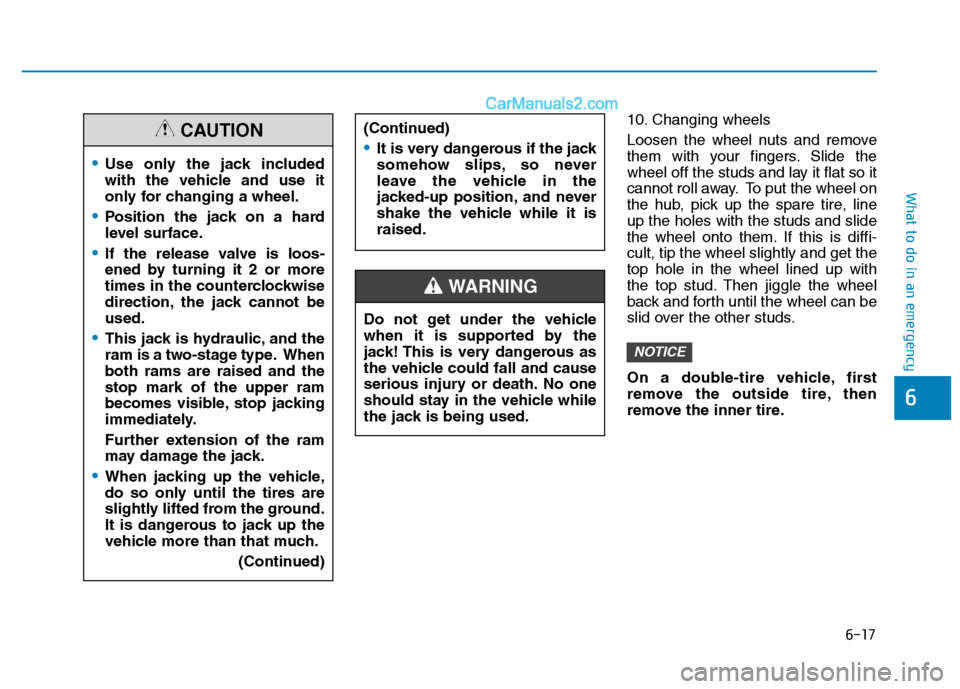
6-17
What to do in an emergency
6
10. Changing wheels
Loosen the wheel nuts and remove
them with your fingers. Slide the
wheel off the studs and lay it flat so it
cannot roll away. To put the wheel on
the hub, pick up the spare tire, lineup the holes with the studs and slide
the wheel onto them. If this is diffi-cult, tip the wheel slightly and get thetop hole in the wheel lined up with
the top stud. Then jiggle the wheel
back and forth until the wheel can be
slid over the other studs.
On a double-tire vehicle, first
remove the outside tire, then
remove the inner tire.
NOTICE
Use only the jack included
with the vehicle and use it
only for changing a wheel.
Position the jack on a hard
level surface.
If the release valve is loos-
ened by turning it 2 or more
times in the counterclockwise
direction, the jack cannot beused.
This jack is hydraulic, and the
ram is a two-stage type. Whenboth rams are raised and thestop mark of the upper ram
becomes visible, stop jacking
immediately.
Further extension of the ram
may damage the jack.
When jacking up the vehicle,
do so only until the tires are
slightly lifted from the ground.
It is dangerous to jack up the
vehicle more than that much.(Continued)
CAUTION(Continued)
It is very dangerous if the jack
somehow slips, so never
leave the vehicle in the
jacked-up position, and never
shake the vehicle while it israised.
Do not get under the vehicle
when it is supported by the
jack! This is very dangerous as
the vehicle could fall and cause
serious injury or death. No one
should stay in the vehicle while
the jack is being used.
WARNING
Page 353 of 473
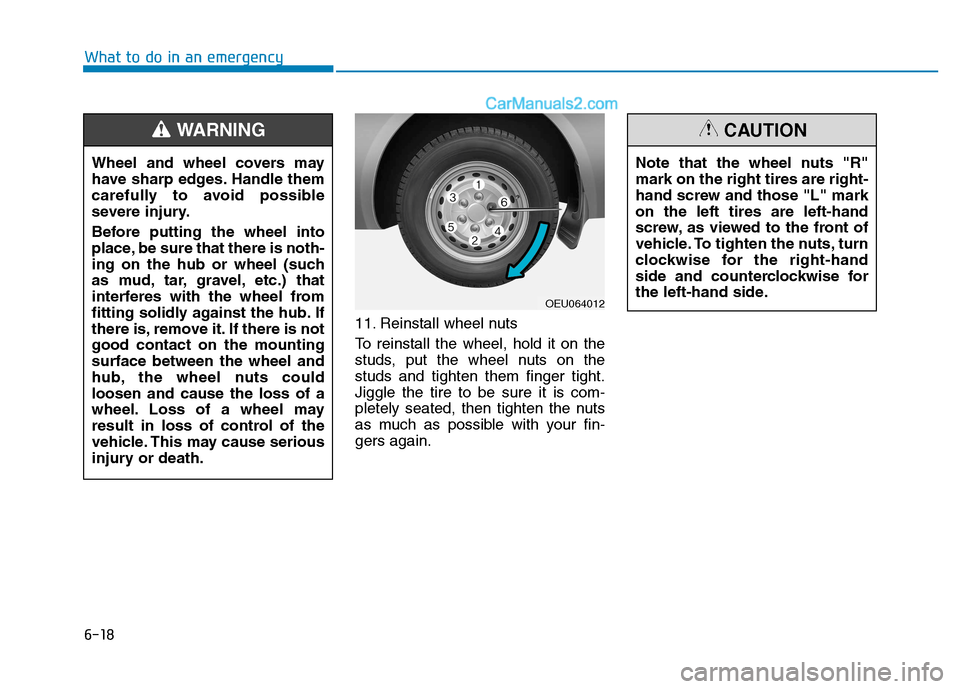
6-18
What to do in an emergency
11. Reinstall wheel nuts
To reinstall the wheel, hold it on the
studs, put the wheel nuts on thestuds and tighten them finger tight.Jiggle the tire to be sure it is com-
pletely seated, then tighten the nuts
as much as possible with your fin-gers again.
Wheel and wheel covers may
have sharp edges. Handle them
carefully to avoid possible
severe injury.
Before putting the wheel into
place, be sure that there is noth-
ing on the hub or wheel (such
as mud, tar, gravel, etc.) that
interferes with the wheel from
fitting solidly against the hub. If
there is, remove it. If there is notgood contact on the mountingsurface between the wheel and
hub, the wheel nuts couldloosen and cause the loss of a
wheel. Loss of a wheel may
result in loss of control of the
vehicle. This may cause serious
injury or death.
WARNING
OEU064012
Note that the wheel nuts "R" mark on the right tires are right-
hand screw and those "L" markon the left tires are left-hand
screw, as viewed to the front of
vehicle. To tighten the nuts, turn
clockwise for the right-hand
side and counterclockwise for
the left-hand side.
CAUTION
Page 355 of 473
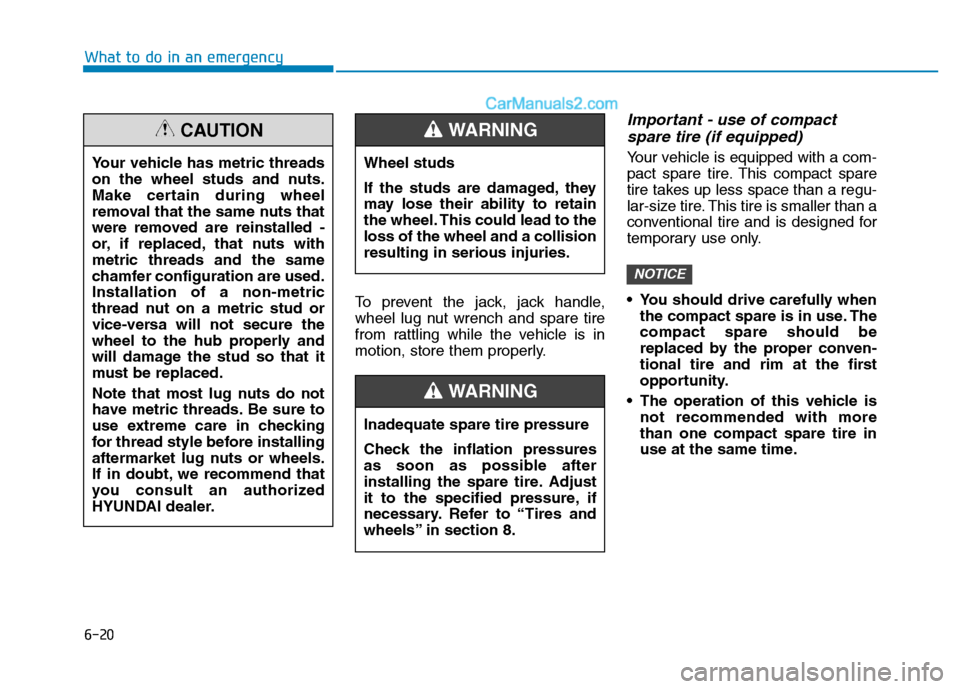
6-20
What to do in an emergency
To prevent the jack, jack handle,
wheel lug nut wrench and spare tire
from rattling while the vehicle is in
motion, store them properly.
Important - use of compactspare tire (if equipped)
Your vehicle is equipped with a com-
pact spare tire. This compact spare
tire takes up less space than a regu-
lar-size tire. This tire is smaller than a
conventional tire and is designed for
temporary use only.
You should drive carefully when the compact spare is in use. The compact spare should be
replaced by the proper conven-
tional tire and rim at the first
opportunity.
The operation of this vehicle is not recommended with morethan one compact spare tire in
use at the same time.
NOTICE
Your vehicle has metric threads
on the wheel studs and nuts.
Make certain during wheel
removal that the same nuts that
were removed are reinstalled -
or, if replaced, that nuts withmetric threads and the same
chamfer configuration are used.Installation of a non-metric
thread nut on a metric stud or
vice-versa will not secure the
wheel to the hub properly and
will damage the stud so that it
must be replaced.
Note that most lug nuts do not
have metric threads. Be sure to
use extreme care in checking
for thread style before installing
aftermarket lug nuts or wheels.
If in doubt, we recommend that
you consult an authorized
HYUNDAI dealer.
CAUTION
Inadequate spare tire pressure
Check the inflation pressures
as soon as possible after
installing the spare tire. Adjust
it to the specified pressure, if
necessary. Refer to “Tires and
wheels” in section 8.
WARNING
Wheel studs
If the studs are damaged, they
may lose their ability to retain
the wheel. This could lead to theloss of the wheel and a collisionresulting in serious injuries.
WARNING
Page 356 of 473
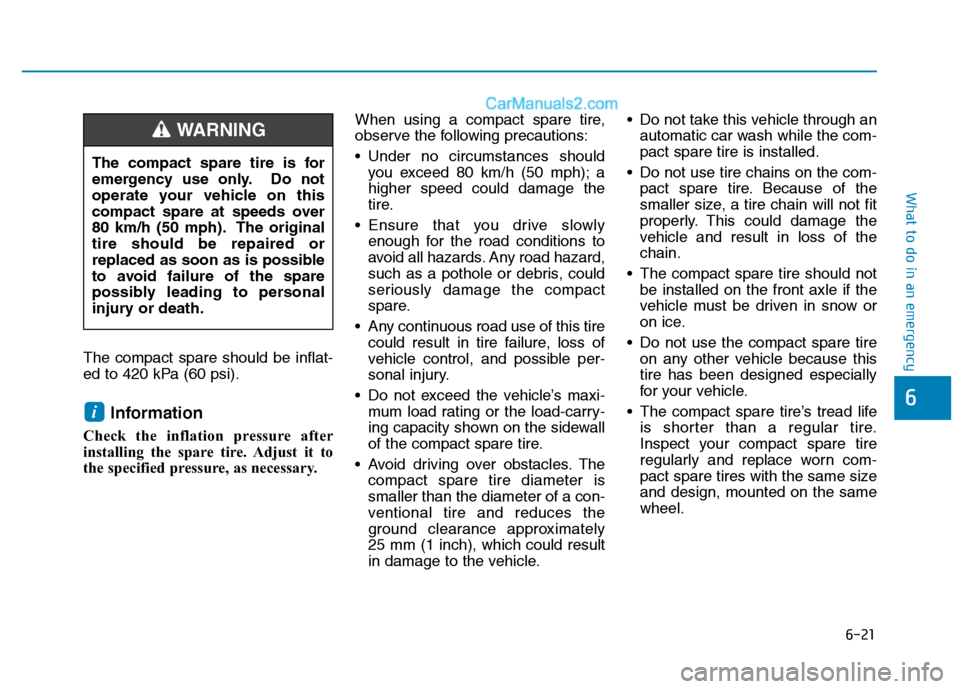
6-21
What to do in an emergency
6
The compact spare should be inflat-
ed to 420 kPa (60 psi).Information
Check the inflation pressure after
installing the spare tire. Adjust it to
the specified pressure, as necessary. When using a compact spare tire,
observe the following precautions:
Under no circumstances should
you exceed 80 km/h (50 mph); a higher speed could damage the
tire.
Ensure that you drive slowly enough for the road conditions to
avoid all hazards. Any road hazard,
such as a pothole or debris, could
seriously damage the compact
spare.
Any continuous road use of this tire could result in tire failure, loss of
vehicle control, and possible per-
sonal injury.
Do not exceed the vehicle’s maxi- mum load rating or the load-carry-
ing capacity shown on the sidewall
of the compact spare tire.
Avoid driving over obstacles. The compact spare tire diameter issmaller than the diameter of a con-
ventional tire and reduces the
ground clearance approximately25 mm (1 inch), which could result
in damage to the vehicle. Do not take this vehicle through an
automatic car wash while the com-pact spare tire is installed.
Do not use tire chains on the com- pact spare tire. Because of the
smaller size, a tire chain will not fit
properly. This could damage the
vehicle and result in loss of thechain.
The compact spare tire should not be installed on the front axle if the
vehicle must be driven in snow or
on ice.
Do not use the compact spare tire on any other vehicle because thistire has been designed especially
for your vehicle.
The compact spare tire’s tread life is shorter than a regular tire.
Inspect your compact spare tire
regularly and replace worn com-
pact spare tires with the same sizeand design, mounted on the samewheel.
i
The compact spare tire is for
emergency use only. Do not
operate your vehicle on this
compact spare at speeds over
80 km/h (50 mph). The originaltire should be repaired or
replaced as soon as is possible
to avoid failure of the spare
possibly leading to personal
injury or death.
WARNING
Page 360 of 473
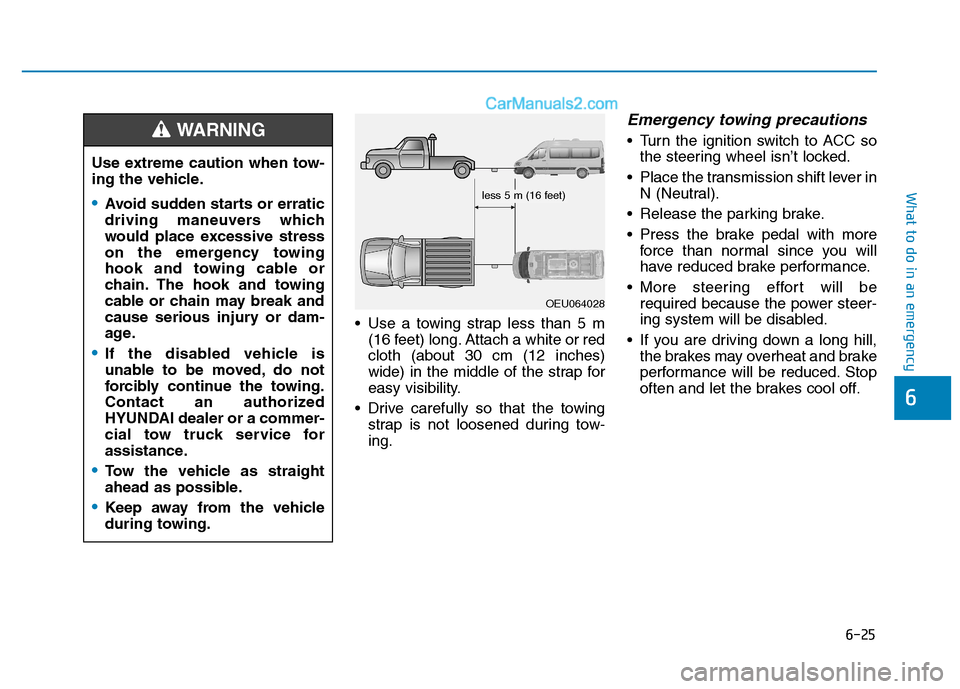
6-25
What to do in an emergency
6
Use a towing strap less than 5 m(16 feet) long. Attach a white or red cloth (about 30 cm (12 inches)
wide) in the middle of the strap for
easy visibility.
Drive carefully so that the towing strap is not loosened during tow-ing.
Emergency towing precautions
Turn the ignition switch to ACC sothe steering wheel isn’t locked.
Place the transmission shift lever in N (Neutral).
Release the parking brake.
Press the brake pedal with more force than normal since you will
have reduced brake performance.
More steering effort will be required because the power steer-
ing system will be disabled.
If you are driving down a long hill, the brakes may overheat and brake
performance will be reduced. Stop
often and let the brakes cool off.
Use extreme caution when tow-
ing the vehicle.
Avoid sudden starts or erratic
driving maneuvers which
would place excessive stress
on the emergency towing
hook and towing cable or
chain. The hook and towing
cable or chain may break and
cause serious injury or dam-
age.
If the disabled vehicle is
unable to be moved, do not
forcibly continue the towing.
Contact an authorized
HYUNDAI dealer or a commer-
cial tow truck service for
assistance.
Tow the vehicle as straight
ahead as possible.
Keep away from the vehicle
during towing.
WARNING
OEU064028
less 5 m (16 feet)